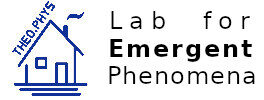PhD thesis – Ellen Fischermeier
Ellen Fischermeier
Simulations of Colloidal Liquid Crystals
finished 2016-01
supervised by Mathhieu Marechal, Klaus Mecke
This thesis presents new insights in the dynamics of colloidal liquid crystals with computer simulations. For this purpose several model systems of increasing complexity are studied. The first model system is the most basic model system possible: a system of hard spherocylinders that only interact via excluded volume. In a next step Brownian motion is included. Finally, also the impact of hydrodynamic interactions is studied.
The thesis is structured as follows: After an introduction to colloidal liquid crystals, the theoretical background is established in the first part of the thesis.
There, first, the observables that can be used to characterize a liquid crystal are presented. Furthermore, the methods by which they can be obtained from computer simulations are explained.
Next, the different algorithms applied in this work are presented. The first of these is a rigid body dynamics algorithm. It treats the particles by Newtons‘ laws of motion and resolves collisions between them as elastic collisions. Within this thesis, this algorithm serves as a molecular dynamics simulation for hard particles.
As a second method, the concept of a Langevin Dynamics simulation is introduced. This algorithm allows for Brownian motion of the particles as it includes stochastic forces and torques. A validation of this method is given via the study of the diffusion of single spherocylinders.
With the next algorithm, a Lattice Boltzmann solver, the solvent of the colloidal system is included explicitly, while, however, Brownian motion is neglected. It is a grid based method that recovers the Navier-Stokes equation in the macroscopic limit. As a validation and first application, the friction coefficients of spherocylinders in a liquid are evaluated.
The final algorithm is a fluctuating Lattice Boltzmann. It is also a grid based method, however, this kind of Lattice Boltzmann simulation recovers the equations of fluctuating hydrodynamics and therefore incorporates both full hydrodynamics and Brownian motion. It is validated in simulations of the diffusion of spheres and spherocylinders.
In the second part of the thesis, the simulation results with the different model systems are presented.
First, the simple hard spherocylinder system without Brownian motion or hydrodynamics is evaluated. This serves both as a validation of the rigid body dynamics framework and allows for more reliable data compared to previous studies, due to decreased finite-size effects. Important system parameters such as the nematic order parameter and the pressure are found to be in good agreement with literature. The results of this thesis on the elastic behavior of this model liquid crystal, namely on the Frank elastic constants, provide presumably the most accurate simulation data available at present.
Next, the influence of external fields on the collective dynamics of a hard spherocylinder liquid crystal is studied by Langevin Dynamics. The chosen external potential acts only on the orientations of the particles and creates a preferred direction of alignment that continuously rotates in a plane. Depending on the rotation frequency of the driving potential and the packing fraction of the particles a rich state diagram develops. Langevin Dynamics simulations allow to understand the complex collective behavior by studying the properties of the motion of individual particles. At low driving frequencies, a regime of linear response is observed, where the particles rotate synchronized with the field. For high driving frequencies a periodic reversal of their rotation direction is found. The wealth of dynamical states at intermediate driving frequencies is explained by the competition of these two types of behavior.
Finally, the diffusive behavior of the particles in the isotropic bulk liquid crystal is studied in the presence of the external potential introduced above. The different consequences of hydrodynamic interactions and steric interactions are established. For this purpose, the dependence of the translational and angular mean squared displacements on the external driving is studied. Furthermore, the coupling of rotational motion to translational diffusion is explored. It is shown that the angular diffusion is always enhanced in the presence of steric interactions. For hydrodynamic interactions, however, this enhancement of the angular diffusion is only observed in the presence of rapidly changing flows. For both types of interaction it is demonstrated that the rotational motion increases the translational diffusion. However, for hydrodynamic interactions this is only observed within the rotation plane while steric interactions also lead to an enhanced diffusion in the perpendicular direction.
The results of all these simulations are summarized in the conclusion.
